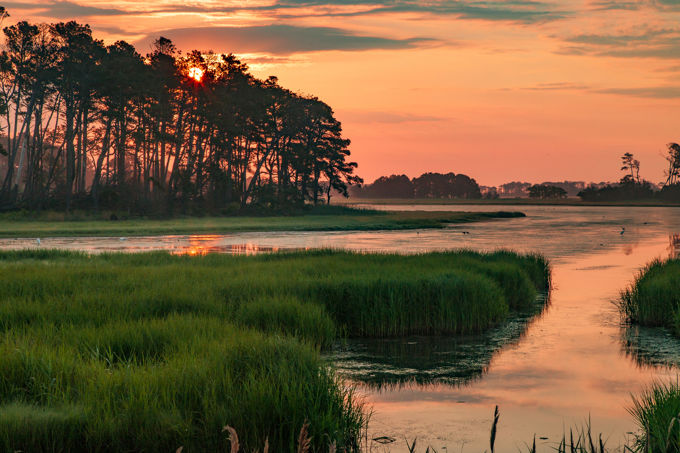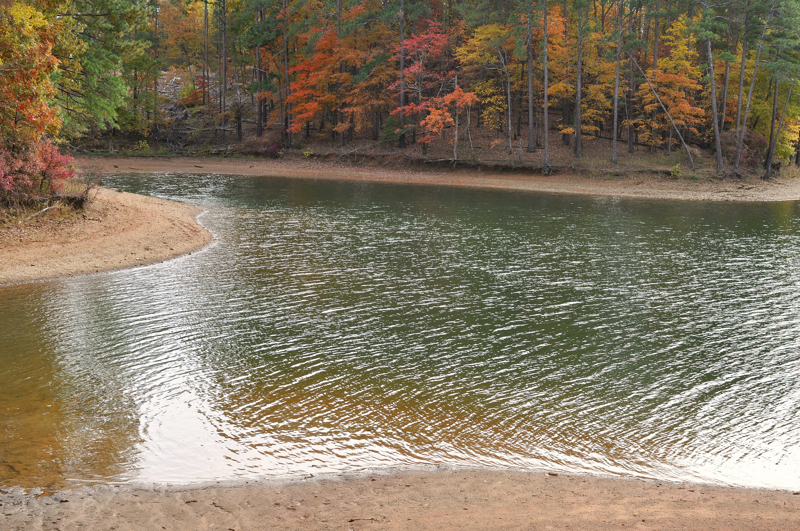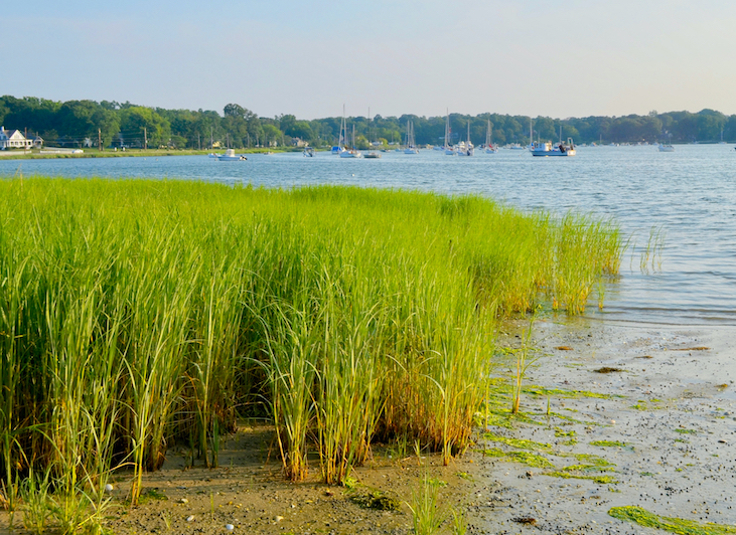
Wetlands Law and Regulation in Virginia
Two Types of Wetlands: Adjacent and Isolated
In order to understand wetland protection laws, it’s important to distinguish between the types of wetlands. We often find wetlands adjacent to a navigable body of water. These adjacent wetlands are the strip of soggy land in the transition between the waterline and the dry upland.
However, there is a second group of wetlands known as isolated wetlands. These are found inland. Isolated wetlands are freshwater and nontidal. They have no surface water connection to a navigable body of water because they are surrounded by dry land. One example of isolated wetlands commonly found in low-lying areas of Virginia is an inland forested parcel with saturated soil that perhaps has standing water at certain times of the year.
Another example of isolated wetlands, not confined to low lying areas, is the strip of soggy land lying between the waterline and the dry upland adjacent to a stormwater retention pond or an agricultural impoundment. Wetlands adjacent to a non-navigable water body are considered isolated wetlands.
There is some controversy about whether to classify as “isolated” a wetlands area located inland that connects to a navigable body of water through, for example, a ditch. Under current law, this type of wetland is characterized as “isolated” unless there is a “significant nexus” between the wetland and the downstream navigable waterway.
Why Do Wetlands Receive Legal Protection?
Wetlands protect water quality, provide fish and wildlife habitat, offer natural floodwater storage, recharge groundwater and protect the shoreline against erosion. Of particular importance to flood prone areas affected by sea level rise, and aggravated by land subsidence, wetlands act like natural sponges on the landscape, absorbing and then gradually releasing storm waters thereby lessening flood damage (one acre of wetlands can store about 1,000,000 gallons of water).
Though some of these features benefit society at large, friction emerges when protecting a particular wetland becomes a pocket-book issue for an individual. 75% of the wetlands remaining in the United States are located on private lands. Many individuals or companies purchase land with the expectation that they can alter it. When that ability is denied, the land is greatly reduced in value with wetlands being viewed as an obstacle to development.

Shutterstock: Jeri Bland
The “No Net Loss” Policy
Prior to the time when the U.S. was settled, there were more than 220 million acres of wetlands in the continental United States. By 2009, this number was reduced by one-half. Despite the national policy goal of “no net loss”, the national inventory of wetlands goes down by about 14,000 acres per year.
What Laws Protect Adjacent Wetlands?
The year 1972 is an important landmark. Wetlands were unprotected prior to 1972. People drained wetlands and filled wetlands so that they could build on them, grow crops on them and build roads across them. There was very little appreciation before the 1970’s of the value of wetlands. Like many coastal cities, much of waterfront Norfolk is built on filled-in wetlands.
This all changed in 1972. The federal Clean Water Act (CWA) adopted in that year included at section 404 a provision that created a federally administered permit program, run by the U.S. Army Corps of Engineers (USACE), to regulate the discharge of fill material into “waters of the United States”. Wetlands adjacent to navigable waters fall easily within reach of the federal program. Less certain is the ability of the federal wetland law program to regulate isolated wetlands.
CWA section 404 gave states the ability to administer their own wetlands permit program, if they wished to do so. Virginia, in 1972, enacted its own law regulating wetlands located adjacent to navigable waters: the Tidal Wetlands Act of 1972. The Virginia Tidal Wetlands Act encouraged localities to regulate the tidal wetlands within their borders by standing up Local Wetlands Boards (LWB). If the locality opted out, then regulatory authority over tidal wetlands fell to the Virginia Marine Resources Commission (VMRC).
Under this dual federal and state/local permit regime, a person seeking to modify a tidal wetland in Virginia needs a separate permit issued by the USACE and one issued by the LWB/VMRC. A person applying for these permits in Virginia need only submit a single application (the Joint Permit Application) to the VMRC, which acts as a clearinghouse for processing the application through all of the federal and state agencies.
Legal Protection for Isolated Wetlands
The ability of the USACE to regulate isolated wetlands has been in great flux over the 50 years since the CWA was adopted in 1972. The reason for this, besides the fact that some view wetland protection laws as an obstacle to development, is that many Americans believe that local government should decide issues of land use. The courts interpreting the CWA hold that the USACE can regulate development in isolated wetlands where those wetlands have a “significant nexus” to a downstream navigable body of water.
The USACE having all power to regulate isolated wetlands creates backlash from so-called property rights advocates and also from those who believe localities should decide land use. The USACE exercise of jurisdiction over isolated wetlands has contributed to section 404 emerging as the single most controversial part of the CWA.
Virginia decided to regulate isolated wetlands with its adoption of the Nontidal Wetlands Act of 2001. The Act places responsibility for regulating isolated wetlands with the Department of Environmental Quality (DEQ), acting through the DEQ’s Virginia Water Protection Program. A person wanting to develop in an isolated wetland will need a permit from the DEQ and perhaps might also need a permit from the USACE.

Shutterstock: Maria T. Hoffman
How Are the Wetlands Rules Enforced?
Persons who violate the wetland laws expose themselves to administrative, civil or criminal enforcement action brought by the federal government or by the Commonwealth of Virginia. On the federal side, $10,000 per violation per day is the maximum penalty that can be imposed administratively (capped at $125,000). If the federal government pursues civil enforcement, then the government files a civil case in the appropriate U.S. District Court against the violator. $25,000 per violation per day is the maximum civil penalty obtainable in this type of litigation (there is no cap), although this maximum has been adjusted upward to account for inflation.
The federal government can also obtain an injunction in this type of litigation, the effect of which is that the violator will be under a court order to take some type of action (typically an order to undo environmental damage caused by the violator). In extreme cases, the federal government has the ability to criminally prosecute a violator, with various levels of fines and prison time of 1 to 15 years (depending on severity).
The Commonwealth of Virginia has a comparable set of enforcement tools, though the monetary penalties and the potential periods of incarceration are lighter than those that apply in a federal enforcement action.
One additional enforcement tool can operate as a wild card. The CWA allows a private citizen to step into the shoes of a government official because it equips any person with evidence of a violation of the CWA (to include a violation of the section 404 wetlands program) to bring a civil enforcement action against the violator in federal court. This feature is called a “Citizens’ Environmental Lawsuit”. If the citizen plaintiff prevails in his or her court case against the violator, the CWA entitles the citizen plaintiff to recover his or her legal fees from the violator, in addition to the civil penalty that the court imposes on the violator, along with an injunction.
Read my blog article on Citizens’ Environmental Lawsuits if you would like to know more about this feature of the law.
Conclusion
Contact Jim Lang if you would like to see him publish more information on the regulation of wetlands in the state of Virginia. Of course, you can always contact Jim for his advice and assistance in connection with needs specific to your particular situation.
